
Amsterdam's Sweeping Challenges
by Ranger Kidwell-Ross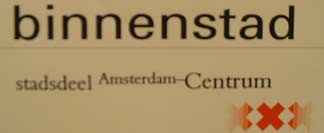
In Amsterdam, I visited with Jan Ditz, manager of one of the four Centrum divisions that maintain the city's downtown area. Accompanying me to this meeting was Kelly Barker, president of a large American sweeping company, Michigan-based Metrosweep Environmental. Kelly happened to be in Amsterdam on other business while I was there, so agreed to take part in the Amsterdam interview and story. In addition to this story, Kelly also wrote a critique of the cleaning job Amsterdam is doing from the perspective of an American contractor. Here's a link to her insightful analysis of Amsterdam's sweeping program. The link to Kelly's story is also shown at the conclusion of this article.
The City of Amsterdam's Centrum agency is responsible for cleaning an area of more than 30 square miles. Like so many tourist-associated cities in Europe, Amsterdam has a rich history, many places to visit and a host of beautiful architecture and scenery. A series of canals runs throughout the city area. Here's what we learned about how the core area of Amsterdam, home to eight million visitors a year, is cleaned.
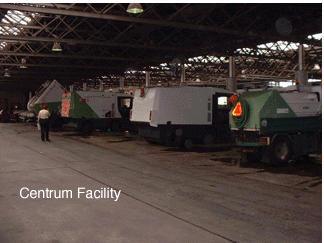
The Centrum agency uses two of the relatively small Schmidt Swingo sweepers for alley sweeping. Their 10 larger Ravo machines (still considerably smaller than most sweepers in the U.S.) can't fit into the tight spaces the Schmidt air sweepers can. However, the Ravos are better for sweeping roadways and for cleaning out the garbage cans. The latter is accomplished by using the Ravo's large vacuum nozzle (think 'catchbasin cleaner'). This unit is stored over the top of the hopper, and conveniently swings out for trash container duty.
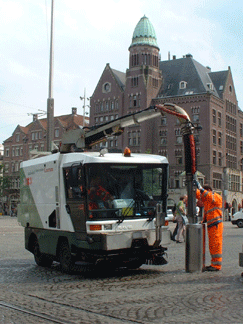
It's a strange sight to see a Ravo machine, with a two-person crew, operating in crowded plazas and streets full of pedestrians, where cars are not allowed. The crew proceeds from garbage can to garbage can, lowering the Ravo's nozzle inside, and efficiently sucking all the debris from each container.
Sweeping the cobblestone areas requires a delicate balance with an air sweeper. The challenge is to pick up the debris between the individual stones without lifting them from the sand they're bedded in. To accomplish this, operators are trained to use the correct rpm on their sweeper to prevent sucking up the roadway with the litter. Cobblestone areas routinely need fixing, and new sand added between the stones. Often, an air sweeper can't be used on the repaired area for two weeks until the sand packs down enough to stay put.
The Centrum agency sweeps most areas by utilizing a 'train' system. First in line is a water truck, outfitted with high-pressure hoses. The powerful water jets blast the debris away from the buildings. Following the water truck is a two- or three-man team with hand brooms that maneuvers the debris to where the sweeper can reach it. Finally, the sweeper follows behind, picking up the material. Sometimes, the entire sweeping 'train' follows a garbage truck that's emptying trash containers in the area.
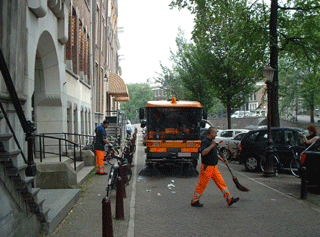
The 'broom men' are a big attraction wherever they go, because their "twig brooms" are made from bundles of tree branches. These have replaced the formerly used, standard push brooms. The pre-made twig bundles are purchased from a supplier, and are very lightweight. When a worker needs a new broom, he simply pulls the old twig bundle off his broom handle and pokes the handle into a new bundle. Wherever I saw the 'broom men,' there were dozens of tourists taking snapshots of them.
Backpack blowers are not used because they're considered too noisy. In order to comply with noise regulations, all sweepers must produce less than 85dBA during operation. And, in the winter, the sweepers aren't used whenever there's a risk their water systems might freeze up. Other than that, they sweep year 'round from 6:15 in the morning to 11:30 at night (23:30). They don't work any later at night, due to noise concerns. The city's outer ring sweeping is entirely residential, and the citizenry doesn't appreciate that much noise in the middle of the night.
All sweeping is done by an agency of the government, and the same agency handles garbage collection. There is no sweeping contractor base as we know it in the U.S. Residential garbage collection is also done by the agency; however, commercial businesses have a choice of having their garbage collected by either the city or a private contractor. They must, however, have it collected. For business garbage collection, the city agency (in this case, Centrum) will bid against private enterprise for handling the service. Most of the collection ends up being done by the city, since they already have the trucks in the area, thus usually end up winning the bid.
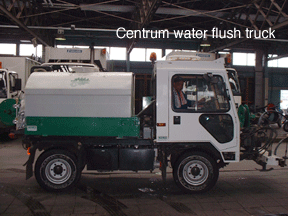
The biggest sanitation problems in Amsterdam are widely cited as 'men peeing and dogs defecating in the streets.' Both have historically been huge factors for the city's cleanliness. (The fine for public urination is now 50 Euros, which is creating some improvement.) Seven days a week, the street cleaning agency sends flusher trucks to the main alleys and other places where the 'offenses' occur most often. With the use of hot water, soap and deodorant the agency tries to keep the mess and odor to a minimum. The peeing problem has been so bad, historically, that a city building with 3-foot thick walls is creating a large logistical dilemma because the odor, over time, has soaked through the brickwork.
Although we had phoned ahead to make arrangements for our interview at Centrum, when we actually arrived, there was no record of our prior communication. Initially, I was told it would be difficult to conduct an interview that day. However, after referencing the ongoing story that was already on the American Sweeper web site, I was told to wait in the lobby and they'd see if arrangements could be made. In about 15 minutes, out walked Jan Ditz, who said he'd be able to handle the interview for us. He politely ushered Kelly Barker and me into his office, where we learned more about how sweeping is done in the Centrum, the heavily-visited core area of Amsterdam.
Ditz used a map to show us the area of Amsterdam his agency is responsible for. Since there are no contractors, and all sweeping is done by the government, I asked how a citizen of Amsterdam could be sure they were getting a good value for the money they were paying for sweeping. "First off," Jan said, "my agency is only handling the inner city. Here in Centrum's area, every street is swept twice per week, and the tourist center is swept seven days a week, twice a day. We also collect garbage twice a week. In total, it is a very high level of performance.
"There's really no way to hand over the work we do to an outside agency. It's too big an operation. The city of Amsterdam is divided into 13 separate entities, which all work separately. We don't collaborate together in any way. In our inner city, alone, we use about 300 people. We divide our Centrum sweeping area into four parts, split off geographically. I'm in charge of the central part of that. Our Centrum agency is completely independent from all the others. We choose how we operate, including the type of equipment and vehicles we use."
In the downtown, core tourist area, there's often a vast accumulation of litter. Unfortunately, the mix includes a large amount of glass. This part of Holland doesn't impose a deposit tax on glass, like Denmark does, although there is a .25 Euro refund on some of the large plastic containers. And, as in Denmark, there is no law that keeps glass off the streets. People drinking beer from glass containers is a common sight, as is broken beer bottle glass sparkling in the cobblestone pavement. However, the city does require that glass be separated from other debris.
Even so, broken glass is an obvious ongoing problem on both the streets and plazas, the majority of which are paved with cobblestones. The gaps between the stones make the glass and other material extremely difficult to remove. Like Copenhagen, Amsterdam could significantly reduce its cleaning challenges if it would incorporate a law that restricts the outdoor use of glass bottles in public places. This is especially true, since both cities allow outdoor alcohol consumption.
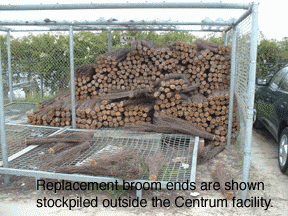
By mandating that no glass be allowed in commercial garbage collection, Ditz told me, Amsterdam has increased the amount of glass available for recycling and, conversely, reduced its worker injury rate. "Now, we have approximately 120 sick days per year due to cut-wounds which, for us, is almost nothing. In the old days, the glass was in the normal garbage and our employee injury rate was much higher. And, we don't have to pay for the weight of the glass when we take it to the burner."
Amsterdam utilizes a unique practice of burying its residential glass and paper recycling bins in the ground. A drop tube is all that's visible above the sidewalk. This is a nice cosmetic change from most cities, where there are large, ugly recycling bins scattered about. The glass and paper are removed via a lift truck. A safety floor rises as the container is lifted, to prevent workers from falling into the shaft while removing the containers. The volume is significant enough to require two trucks to traverse the area six days a week to empty the recycling containers.
Cans, however, are thrown into the rest of the garbage stream. They're separated later when the garbage bags go through a type of shredder that allows the metal (cans aren't made of aluminum) to be removed by a large magnet. Amsterdam's general population appears less-than-ideally informed with regard to waste collection. No one I asked could tell me, for certain, whether or not the cans they threw away were recycled. Most people 'thought maybe' or 'assumed' the cans were removed prior to the garbage being burned.
All of Amsterdam's garbage stream is incinerated in a burner that produces electricity. Although this facility is run by another part of the government, the City of Amsterdam is required to pay tipping fees like other users.
The City also handles graffiti removal. This is done, gratis, on all government property, and is available for hire, commercially, to any businesses that need the service. Interestingly, any racist graffiti on any surface, public or private, is immediately cleaned on a priority basis, at no charge.
I expressed my surprise that the police horses are allowed to defecate on the highly-traveled pedestrian plazas at will, but there is a huge uproar in the town's tourism media over the large number of dog piles dotting the plaza landscapes. "It's very funny," Jan said with a wry laugh of his own. "The police give you a ticket when your dog does that on the sidewalk, and yet they are calling us to come clean up after their horses. To get it cleaned up as quickly as possible, we have a man who travels the central core tourist area all day long with a little sweeper."
Since Amsterdam is known as a place where 'soft' drugs are allowed, I asked what is done about workers who abuse either marijuana or alcohol. "We are not allowed, by law, to conduct drug testing or screening," Ditz said, "However, when I suspect someone of 'blowing or drinking' I have to make very sure it is taking place. When a manager smells liquor on a worker, or sees them blowing a joint, the person is sent home. Because we are a government agency, documentation has to be very thorough in order for dismissal to take place. On the other hand, we cannot afford to have workers operating a machine like a 5,000 kilogram Ravo sweeper under the influence of any drugs. When it happens a time or so to any particular person, they are released. That's when the fight starts with the unions, etc."
Amsterdam is a city of stunning architecture and lovely canals running throughout the city, yet there appears to be little, if any, awareness that trash should go into a proper container. As a result, there is a large-scale littering problem in Amsterdam. During my time spent in the city, I really couldn't determine whether the majority of litter is generated by tourists or by the local population. I asked the opinions of a number of shop owners and other residents, and got a surprisingly mixed reaction. Some think tourists are the main culprits, but a large percentage believe there's a need for more public awareness among the local population. My own sense is that the locals don't assign a negative value to littering. This, in turn, creates an atmosphere that practically encourages visitors to throw stuff on the street, as well.
Perhaps because Amsterdam is considered a European party city, given its acceptance of soft drugs, sex and outdoor alcohol consumption, it's naturally assumed it's okay to throw litter onto the ground, too. In any event, there appears to be little inclination to put litter into a proper container.
Ditz's opinion is that it's mostly a tourism problem. "We have eight million visitors per year, and it's as if we have a sign on the entrance to the city that says 'Welcome to Amsterdam, the city where you can do anything you'd like.' That seems to include throwing anything you don't want onto the ground.
"Every day, approximately 85,000 people commute to the city to work. And we get more than 20,000 visitors a day in our city center. It's very difficult to instill an awareness in those people that we don't want our city trashed by them. So far, we can't seem to reach them, so what we do is to clean up after them. That doesn't mean we've given up on education programs. At the moment, we are using a series of radio commercials that translate to: 'With the same effort, you can put it into the trash container.' When you combine the influx of people we see every day with the large events that happen nearly every summer weekend, it's more like having to clean up a large 'Disneyland-type' theme park than a city.
"We also have daily patrols to make sure people don't put their garbage out on the wrong day, which is also a big problem. There's some amount of simply tossing bags into the street and, when this happens, it's difficult to determine where they came from. Although we routinely go through the bags in an attempt to find out who they belong to, people are getting smarter about removing any type of identification from the bags. These aren't people who are trying to get service for free, since everyone pays a pickup fee in their energy bill. They just want the garbage out of their house, or they just don't care.
"Another issue we deal with is electrical items that won't fit into garbage receptacles. People are supposed to call to have their worn out electrical items picked up but, since there is a disposal fee for them, they are just as likely to put them next to the residential area garbage bins. Tire disposal/pickup is also a problem. We have six locations that people can bring their tires to for free disposal (a disposal fee is part of a new tire purchase). However, many people don't want to bother, so they just leave them out on the street and figure we'll pick them up.
"There is a disposal fee built in to all new appliances. The shops that sell them are supposed to take away your old one at no charge. However, it doesn't work very well for a variety of reasons. One is that they tend to deliver the new appliance and 'forget' to remind the customer that they'll take the old one away. So, five days a week, we drive around the city collecting electrical appliances of all types. We have another vehicle that collects all the used computers and disposes of them in a certain way. Many components are taken out of computers prior to them being incinerated."
Canal cleanliness is what appears, to this visitor, as the agenda item needing to be pushed forward as soon as possible. For example, there's no question that the 'broom men' who precede the sweeper are responsible for a substantial amount of dirt and debris getting into the canals. Although they broom the edges with the intent of directing the material away from the canal, I'd estimate (from what I observed) that up to a third of it actually goes the wrong way. Since there were no curb lips on the canals in any of the places I investigated, there's no way to keep storm water runoff contained, as is done in Copenhagen. Once the city becomes more aware of the toxicity of the fine particulate matter in its streets, my guess is the next step will be to contain all its street edges where material is now getting into the canals.
"Until about 15 years ago," Jan said, "all the sewer systems were connected to the canals. Then, we'd get dirt and debris off the streets by using a sort of flusher truck. With use of its water spray, everything from the streets pretty much ended up in the canals. Now, that has all changed. There are a few buildings that are still dumping sewage in, but it's negligible, and we're working to keep street dirt out of the canals now, too.
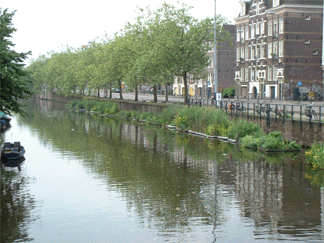
"There is another department that's responsible for cleaning the canals. They have boats that collect up everything that floats. They also run a boat that uses a crane to remove large items that have been dumped into the canals, like bicycles, appliances and who knows what else. The quality of the water is getting better. We've added floating islands of plants in some parts of the canal to help this process along. These help the small fish hide from the big fish and introduce small creatures into the food chain that help clean the water." [I tried unsuccessfully to find the 'boat sweeper' so I could take pictures. As you can see from the photo, I did locate one of the floating islands.]
Until only about three months ago, the department pumped water from the canal for use in its water trucks and dust suppression systems. However, city workers expressed a concern about diseases they might contract as a result of breathing the spray. When the water was checked for contaminants, the level of at least one toxic chemical (Ditz didn't know which one) was too high in some areas. The end result is they've stopped pumping canal water for this use. Now, drinking water is being used in both their sweepers and the water trucks, even though it's more expensive.
Ditz said the agency is committed to obtaining a level of cleaning that will earn them a 'cleanliness degree.' "Ultimate clean is 10, and we are committed to raising our current score of 7.3 to where we can score a minimum of 8 at all times. Getting to 8 will be very difficult. Scoring is done by another division of the agency that, on a weekly basis, rates how the sweeping division is doing. Several areas in the Centrum section are measured every week, and others are chosen for review at random.
It appears that, with regard to cleaning its paved surfaces, the City of Amsterdam faces a very difficult challenge for several reasons: scarcity of parking, which means cars are always parked along the city roadways, a never-ending glut of tourists, and the city's resident population having little hesitation in littering. Also, the very nature of the cobblestone surfaces, which are in widespread use, exponentially increases the difficulty in doing a good job.
And, as the toxicity of roadway debris increases, Amsterdam will need to develop more effective ways to keep material on the road surfaces from getting into the canals. This combination of factors will continue to make street sweeping in the city an extremely daunting task.
You may also want to take a look at Amsterdam's sweeping program from the perspective of American sweeping contractor, Kelly Barker.
CDL equivalent in Amsterdam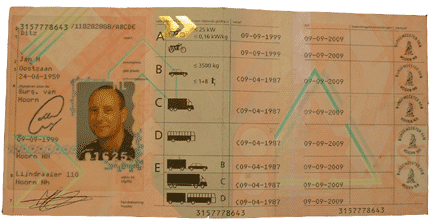
Jan Ditz showed us his equivalent license to our Commercial Drivers License (CDL). Here's how the system works in Holland. To drive a truck requires testing for a 'C' class of license. When the truck is above 7,500 kilos, what is called a 'Chauffeurs Diploma' is required. For this, a person must go through a special driving school, and a series of four tests is required. A new type of diploma, and the training that goes along with it, is required if there are to be passengers in the commercial vehicle that's being driven. For semis, another endorsement is required. You can see by looking at the photos what the different attainment levels are. Centrum requires garbage truck operators to have a 'C' license and a Chauffeurs License, and tries to have three certified operators per sweeper team. That way, they can trade off so that no one gets too tired by the end of the day. Workers under 40 are supposed to collect no more than 6.4 tons per day, and for those over 40 the law requires that this amount drops to 4 tons per day. Ditz said that the agency finds other work for its over-40 workers as alternatives to garbage collection. The garbage trucks are scheduled to pick up 17 tons per 3-person crew so as to not go over the legal labor guidelines. |
Our next installment takes us to Paris, currently embroiled in a municipal workers' strike that is keeping the streets unswept, garbage largely uncollected, and making public travel throughout the city and country both difficult and unreliable.
 |
 |
Back to Table of Contents for Sweeping in Europe
© 2005 - 2021 World Sweeper |